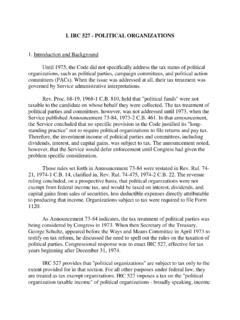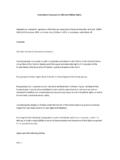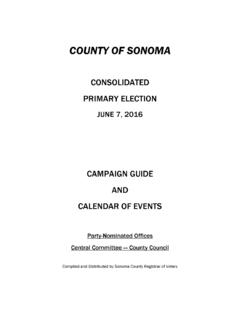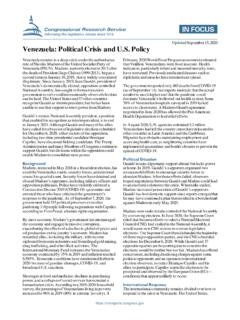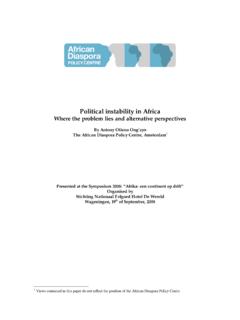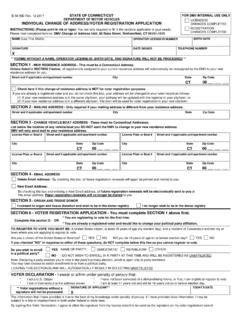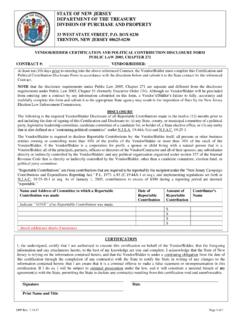Transcription of Women in Power and Decision-Making - United Nations
1 Women in Power and Decision-Making 1. Global commitments This chapter of the Platform for Action focuses on achieving effective participation by Women in Decision-Making in elected bodies, public administrative entities, political parties, the judiciary and civil society. The Platform sets out two strategic objectives. Take measures to ensure Women s access to and full participation in Power structures and Decision-Making . Increase Women s capacity to participate in Decision-Making and leadership. Two articles of the Convention on the Elimination of All Forms of Discrimination against Women (CEDAW) deal with Women s participation in political and public life.
2 Article 7 commits States parties to ensure equality between Women and men in political and public life, including the right to vote, to be eligible for election, to participate in formulating government policy, to hold public office and to perform public functions. The Convention includes the right to participate in non-governmental organisations and other associations. Article 8 requires States parties to ensure that Women have equal opportunities with men to represent their governments at the international level and to participate in the work of international organisations. The Committee on the Elimination of Discrimination against Women provided additional guidance in the implementation of the Convention in 1997 in its General Recommendation 23, which highlighted the application of the Convention to all levels of government and to the activities of a range of organisations concerned with public and political life, including public boards, local councils, and the activities of political parties, trade unions and professional associations.
3 General Recommendation 23 also stated that: It is the Government's fundamental responsibility to encourage these initiatives to lead and guide public opinion and change attitudes that discriminate against Women or discourage Women 's involvement in political and public life. 1 The Commission on the Status of Women continued to pay attention to the issue and adopted agreed conclusions on Women and Decision-Making processes in 1997 and In its resolution 1325 (2000) on Women , peace and security, the Security Council called on Member States to increase the representation of Women in all institutions and mechanisms dealing with the prevention, management and resolution of conflict, including as special representatives and envoys of the Secretary-General and within the field operations as military observers, civilian police, human rights and humanitarian personnel.
4 The importance of the issue has been recognized within the framework of the Millennium Development Goals. One of the indicators for monitoring Millennium Development Goal 3 on gender equality is the proportion of seats held by Women in national parliaments. The 2005 World Summit Outcome reaffirmed the commitments to increased representation of Women in government Decision-Making bodies, including opportunities to participate fully in the political - 1 - 2. Progress at the national level Marked progress has been made since 1995 in the numbers of Women elected to national parliaments. The table below includes the 20 countries that achieved over 30 per cent representation of Women in 2006, which compares favourably with the very short list of 5 countries that had achieved this in 1995 (Denmark, Finland, the Netherlands, Norway, Sweden).
5 4 Rwanda achieved per cent representation of Women in the 2003 elections, a dramatic increase from the per cent representation in 1995 that illustrated the positive results of focused and coordinated efforts to address this issue in the period of post-conflict reconstruction. Several other countries in the table are also post-conflict countries: Burundi, Mozambique, and South Africa. As noted by the Inter-Parliamentary Union, for countries in transition, the process of establishing new constitutions and institutions and rewriting the rules of the political landscape provides a golden opportunity for Women to influence the process and make their voices heard, especially in the drafting of electoral and political party laws.
6 5 It is also notable that, in addition to the post-conflict group, there is one other country in Sub-Saharan Africa and another four in Central and South America that have passed the 30 per cent threshold and have considerably higher representation of Women than a number of OECD countries with more resources and more established traditions of electoral politics, again demonstrating that the advancement of Women is possible through political will and targeted action. Almost all of the countries 20 countries included in the table have used some form of electoral quotas to ensure that Women account for a certain number of percentage of candidates for office or officeholders, whether through a constitutional commitment, a provision of election legislation, voluntary action by political parties, or some combination of - 2 - Women in national parliaments, 2006 Country % Women Last elections Electoral system If quota & type of quota Rwanda 2003 List PR Yes constitutional commitment.
7 Legislation establishing 30% reserved seats (indirectly elected) Sweden 2002 List PR Yes voluntary party quotas for candidates Costa Rica 2006 List PR Yes legislated quota of 40% Women candidates on party lists Norway 2005 List PR Yes voluntary party quotas for candidates Finland 2003 List PR No Denmark 2005 List PR No but did have at times in the past Netherlands 2003 List PR Yes voluntary party quotas for candidates Cuba 2003 Majority * No Spain 2004 List PR Yes voluntary party quotas
8 For candidates Argentina 2005 List PR Yes constitutional commitment; legislated quota of 30% Women on party lists; political party quotas for candidates Mozambique 2004 List PR Yes voluntary party quotas for candidates Belgium 2003 List PR Yes legislated quota of 33% Women on party lists Austria 2002 List PR Yes voluntary party quotas for candidates Iceland 2003 List PR Yes voluntary party quotas for candidates South Africa 2004 List PR Yes voluntary party quotas for candidates New Zealand 2005 Mixed M & PR No Germany 2005 Mixed M & PR Yes voluntary party quotas for candidates Guyana 2001 List PR Yes constitutional requirement for 33% quota for Women on electoral
9 Lists Burundi 2005 List PR Yes constitutional commitment, legislated quota of 30% Women on party lists Tanzania 2005 FPTP Yes constitutional quota, election law quota regulation (special seats) PR= proportional representation; Mixed M & PR = combination of member and proportional representation; FPTP = first past the post; * in Cuba, the single nominated candidate must get the support of the majority of the electorate Sources: IPU (2006). Women in Politics: 60 years in retrospect; IPU database on Women in national parliaments; and IDEA International quota database.
10 Most countries have elected bodies at sub-national levels, some with state or provincial governments and most with elected local councils. Very little data is available for the intermediate (state or provincial level), but a database on Women councillors and mayors is being developed by the organisation United Cities and Local Governments (UCLG) as part of their Global Programme on Women in Local Decision-Making . UCLG s conclusions from the preliminary and partial data available in 2005 were that 20 per cent of councillors overall were Women and that the participation of Women in local politics was increasing - 3 - A number of countries have used constitutional or legislative quota systems to advance progress toward more equitable representation at the local level.










